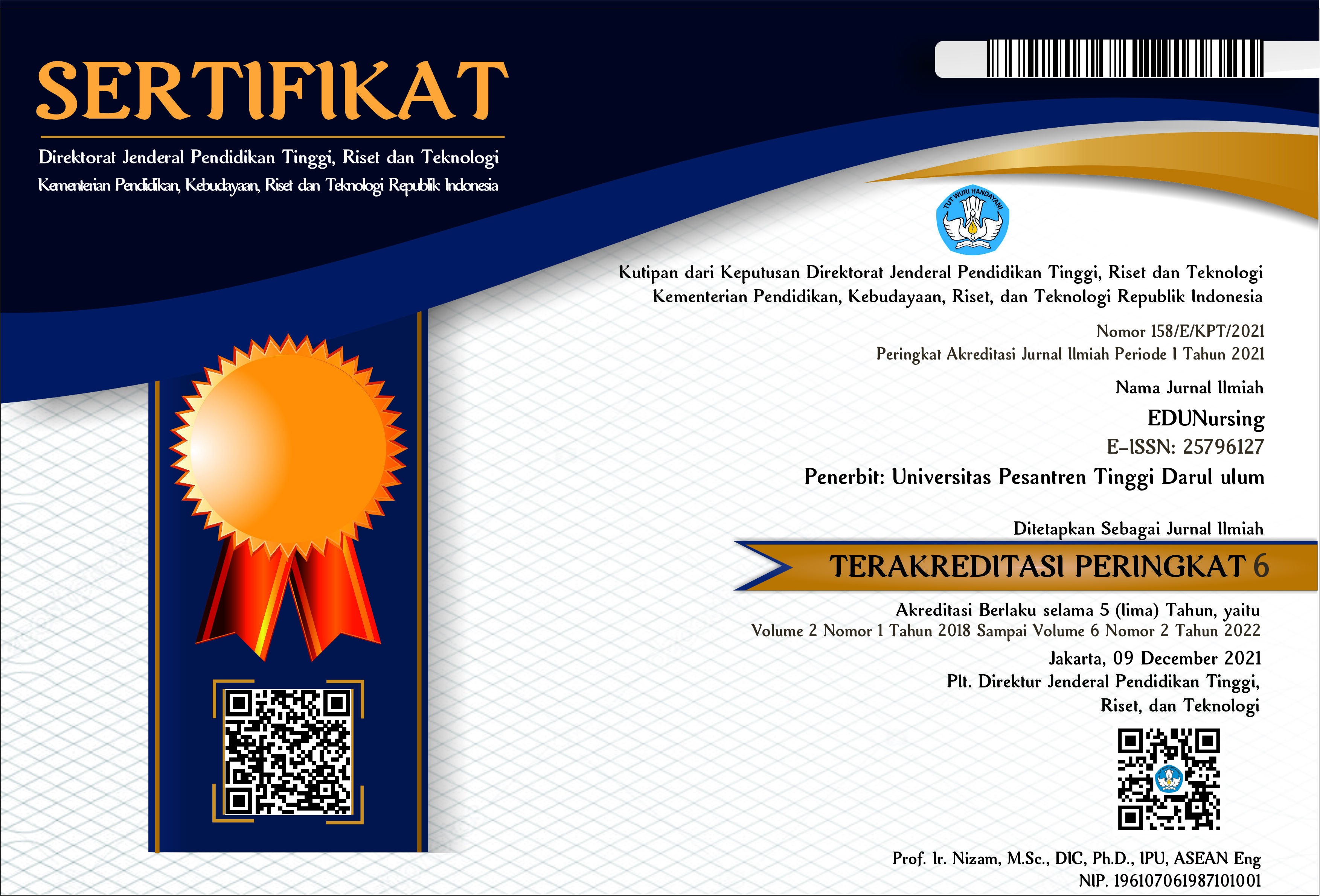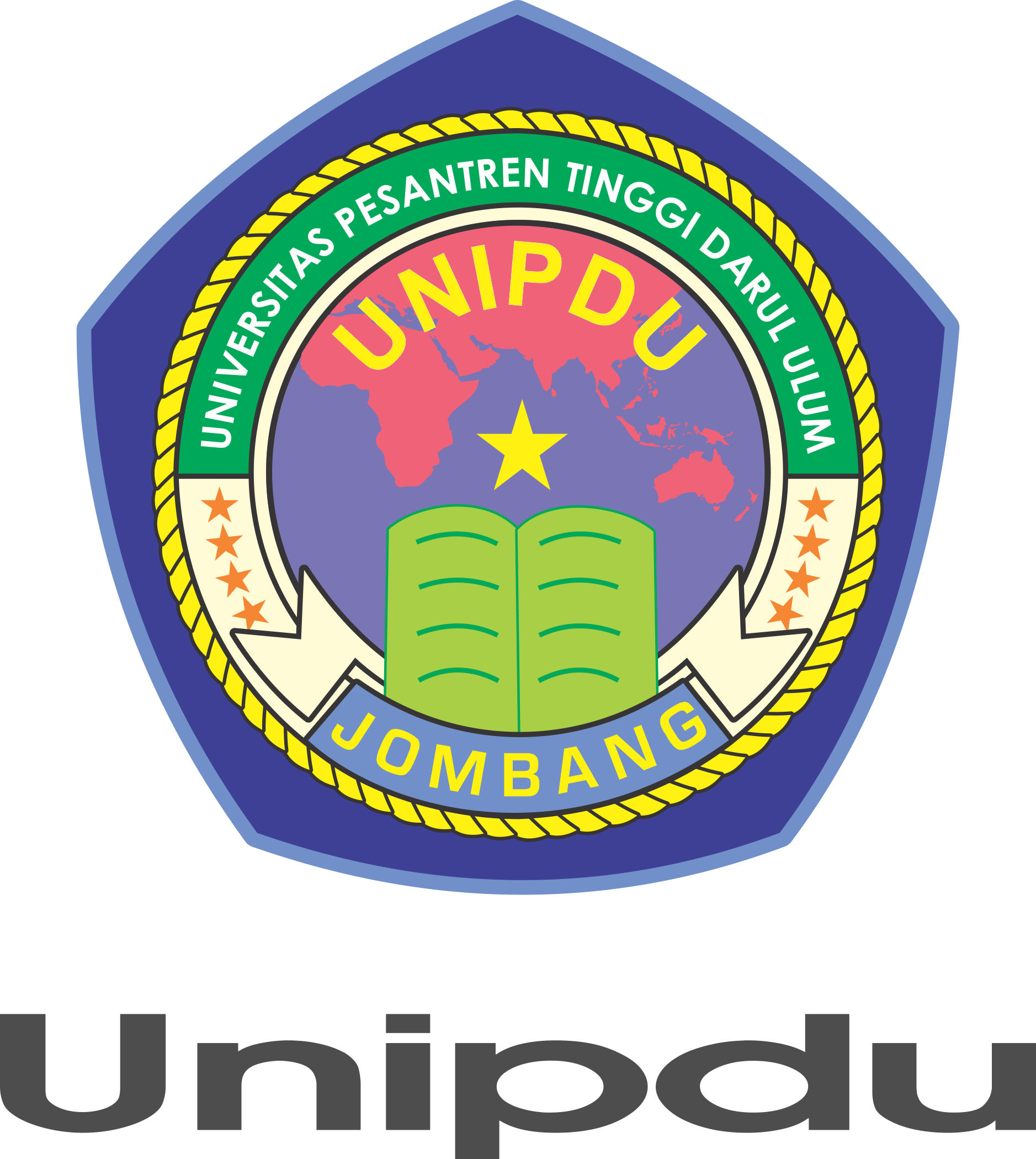HUBUNGAN STATUS GIZI IBU SELAMA HAMIL DENGAN KEJADIAN STUNTING PADA BAYI USIA 0-12 BULAN DI WILAYAH KERJA PUSKESMAS KENJERAN SURABAYA
https://doi.org/10.26594/edunursing.v4i1.1917
Abstract
ABSTRACTMaternal nutritional status during pregnancy explains that maternal weight gain during pregnancy is recommended based on body mass index before pregnancy. Mothers who experience poor nutritional status are at risk of giving birth to LBW infants so that children are at risk of stunting. The purpose of the study was to analyze the relationship of maternal nutritional status during pregnancy with the incidence of stunting in infants aged 0-12 months in the work area of Kenjeran Health Center Surabaya. The design of the analytical correlation study with the retrospective cohort approach in 4 sub-districts included Kenjeran, Bulak, Kedung Cowek, Sukolilo Village. The sample technique used Stratified Random Sampling as many as 108 mothers who had infants aged 0-12 months. Data retrieval is done by questionnaire sheets and observations using KIA books, midline and z-score tables. The results of the study showed that most mothers experienced nutritional status during pregnancy. Mothers who experience nutritional status during pregnancy are less likely to cause children at risk of stunting. The Spearman rho test showed a correlation between maternal nutritional status during pregnancy and the incidence of stunting ? = 0,000 (? <? = 0.05). The implication of this study is that the nutritional status of mothers during pregnancy is related to the incidence of stunting, so that it can be socialized about health education about stunting and nutritional needs that must be met during pregnancy to health workers at the Kenjeran Health Center Surabaya.
Keywords: Maternal Nutritional Status During Pregnancy, Stunting, Infants
References
DAFTAR PUSTAKA
Aramico, Sudargo, T., & Susilo, J. (2013). Hubungan Sosial Ekonomi, Pola Asuh, Pola Makan dengan Stunting pada Siswa Sekolah Dasar di Kecamatan Lut Tawar Kabupaten Aceh Tengah. Jurnal Gizi Dan Dietetik Indonesia.
Ariani, A. P. (2017). Ilmu Gizi Dilengkapi Dengan Standar Penilaian Status Gizi dan Daftar Kompisisi Bahan Makanan. Yogyakarta: Nuha Medika.
Bishwakarma. (2011). Spatial Inequality in Children Nutrition in Nepal: Implications of Regional Context and Individual/Household Composition.
Boylan, S., Mihrshahi, S., Chun, J., Louie, Y., Rangan, A., Norsal, H., … Gill, T. (2017). Prevalence and Risk of Moderate Stunting Among a Sample of Children Aged 0 – 24 Months in Brunei. Maternal and Child Health Journal, 21(12), 2256–2266. https://doi.org/10.1007/s10995-017-2348-2
Chapakia. (2016). Hubungan Riwayat Berat Badan Lahir (BBL) dengan Perkembangan Motorik Halus Anak Usia 2-5 Tahun di Posyandu Gonilan Kartasura.
Damayanti, & Muniroh. (2016). Pemberian ASI Eksklusif pada Balita Stunting dan Non Stunting. Media Gizi Indonesia.
Emamian, M. H., Fateh, M., & Gorgani, N. (2015). Mother ’ s education is the most important factor in socio-economic inequality of child stunting in Iran, 17(9), 2010–2015. https://doi.org/10.1017/S1368980013002280
Hagos, S., Hailemariam, D., Woldehanna, T., & Lindtj, B. (2017). Spatial heterogeneity and risk factors for stunting among children under age five in Ethiopia : A Bayesian geo-statistical model, 1–19. https://doi.org/10.1371/journal.pone.0170785
Hidayati, D., & Thaib, T. . (2010). Faktor-faktor Yang Berhubungan dengan Stunting Pada Balita Usia 12-59 Bulan di Kecamatan darul Kamal Kabupaten Aceh Besar.
Ikeda, Yuki, & Shibuya. (2013). Determinants of reduced child stunting in Cambodia: Analysis of pooled data from three demographic and health surveys. Bulletin of the World Health Organization.
Kemenkes, R. I. (2010). Standar Antropometri Penilaian Status Gizi Anak.
Kusumawati, E., Rahardjo, S., Sari, H. P., Kesehatan, J., Fakultas, M., Universitas, I. K., & Soedirman, J. (2013). Model Pengendalian Faktor Risiko Stunting pada Anak Usia di Bawah Tiga Tahun Model of Stunting Risk Factor Control among Children under Three Years. Jurnal Kesehatan Masyarakat Nasional, 9, 249–256.
Kusumawati, E., Rahardjo, S., & Sistiarani, C. (2017). Multilevel Intervention Model to Improve of Mother and Children in Banyumas Regency. Jurnal Kesehatan Masyarakat, 12(2).
Loya, & Nuryanto. (2017). Pola Asuh Pemberian Makan Pada Balita Stunting Usia 6-12 Bulan di Kabupaten Sumba Tengah Nusa Tenggara Timur. Journal of Nutrition College.
Maharani, R., Hadju, V., & Zakaria. (2013). Gambaran Antenatal Care dan Status Gizi Ibu Hamil di Pesisir Tallo Kecamatan Tallo Kota Makassar.
Matsungo, T. M., Kruger, H. S., Faber, M., Rothman, M., & Smuts, C. M. (2017). The prevalence and factors associated with stunting among infants aged 6 months in a peri-urban South African community, 20(17), 3209–3218. https://doi.org/10.1017/S1368980017002087
Medhin, G., Hanlon, C., Dewey, M., Alem, A., Tesfaye, F., Worku, B., … Prince, M. (2010). Prevalence and predictors of undernutrition among infants aged six and twelve months in Butajira , Ethiopia : The P-MaMiE Birth Cohort.
Milton, A. H., Shahidullah, S. M., Smith, W., Hossain, K. S., & Hasan, Z. (2010). Association between Chronic Arsenic Exposure and Nutritional Status among the Women of Child Bearing Age : A Case-Control Study in Bangladesh, 2811–2821. https://doi.org/10.3390/ijerph7072811
Moehji. (2013). Ilmu Gizi I. Jakarta: Bratara Karya Aksara.
Ni’mah, K., & Nadhiroh, S. R. (2015). Faktor Yang Berhubungan Dengan Kejadian Stunting Pada Balita. Media Gizi Indonesia.
Nirbita, E. M. (2012). Hubungan Antara Status Gizi Ibu Hamil dengan Bayi Berat Lahir Rendah (BBLR) di Puskesmas Bangsal Mojokerto. Universitas Airlangga.
Nurhayati, E. (2016). Indeks Massa Tubuh (IMT) Pra Hamil dan Kenaikan Berat Badan Ibu Selama Hamil Berhubungan dengan Berat Badan Bayi Lahir. Jurnal Ners Dan Kebidanan Indonesia, 4.
Pantaleon, Hadi, & Gamayanti. (2015). Hubungan Status Gizi Dengan Perkembangan Anak Usia 1 Sampai 5 Tahun Di Kelurahan Tidar Utara Kota Magelang.
Pelizzo, G., Calcaterra, V., Fusillo, M., Nakib, G., Ierullo, A. M., & Alfei, A. (2014). Malnutrition in pregnancy following bariatric surgery : three clinical cases of fetal neural defects, 13(1), 1–6. https://doi.org/10.1186/1475-2891-13-59
Puspitaningrum, E. M. (2018). Hubungan Status Gizi Ibu Hamil dengan Kejadian Berat Badan Lahir Rendah (BBLR) di RSIA Annisa Kota Jambi. Akademi Kebidanan Mitra Sejahtera.
Rahayu, A., & Khairiyati, L. (2014). Risiko Pendidikan Ibu Terhadap Kejadian Stunting Pada Anak 6-23 Bulan. Penel Gizi Makan, 37(Ci), 129–136. https://doi.org/10.22435/PGM.V37I2.4016.129-136
Rahayuh, A., Yulidasari, F., Putri, A. O., Rahman, F., & Rosadi, D. (2016). Faktor Risiko yang Berhubungan dengan Kejadian Pendek pada Anak Usia 6-24 Bulan. Jurnal Kesehatan Masyarakat, 11(2).
Rahman, T., Adhani, R., & Triawanti. (2016). Hubungan Antara Status Gizi Pendek (Stunting) Dengan Tingkat Karies Gigi. Dentino Jurnal Kedokteran Gigi, I(1), 88–93.
Sartono. (2013). Hubungan Kurang Energi Kronis Ibu Hamil dengan Kejadian Stunting pada Anak Usia 6-24 Bulan di Kota Yogyakarta.
Schmid, B., Eppler, M., Lechner, U., Schmid-Isler, S., Stanoevska, K., Will, M., & Zimmermann, H.-D. (2018). Ein Glossar für die NetAcademy. Institute for Media and Communications Management, Jahrgang(Nummer), Seitenzahl von-bis.
Setiawan, E., Machmud, R., & Masrul. (2018). Faktor-faktor yang Berhubungan dengan Kejadian Stunting pada Anak Usia 24-59 Bulan di Wilayah Kerja Puskesmas Andalas Kecamatan Padang Timur Kota Padang Tahun 2018. Jurnal Kesehatan Andalas, 7 (2), 276. Retrieved from http//jurnal.fk.unand.ac.id
Sitoresmi, Kusnanto, & Krisnana. (2015). Perkembangan Motorik Anak Toddler pada Ibu Bekerja dan Ibu Tidak Bekerja. Jurnal Pediomaternal.
Susilowati, & Kuspriyanto. (2016). Gizi Dalam Daur Kehidupan. Bandung: Refika Aditama.
Tri, K. (2015). Hubungan Status Gizi Ibu Saat Hamil Dengan Kejadian Stunting Pada Anak Usia 6-23 Bulan Di Kabupaten Bantul.
WHO. (2014). WHA Global Nutrition Targets 2025: Stunting Policy Brief. Geneva: World Health Organization.
WHO, UNICEF, & Group, W. B. (2018). Levels And Trends in Child Malnutrition.
Zaif, R. M., Wijaya, M., & Hilmanto, D. (2017). Hubungan antara Riwayat Status Gizi Ibu Masa Kehamilan dengan Pertumbuhan Anak Balita di Kecamatan Soreang Kabupaten Bandung. Jurnal Sistem Kesehatan, 2(3), 157.
Zapata-fajardo, P. E., & Mayta-trista, P. (2019). Relationship between stunting in children 6 to 36 months of age and maternal employment status in Peru : A sub-analysis of the Peruvian Demographic and Health Survey, 1–17. https://doi.org/10.1371/journal.pone.0212164
Downloads
Published
How to Cite
Issue
Section
License









